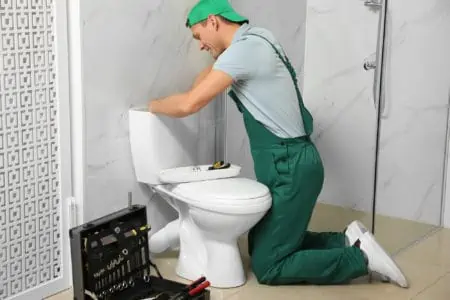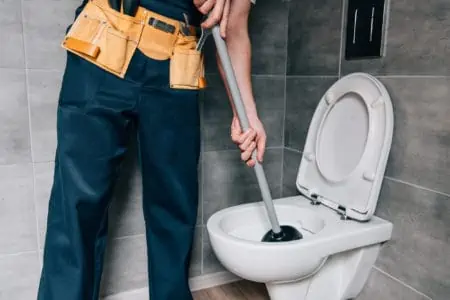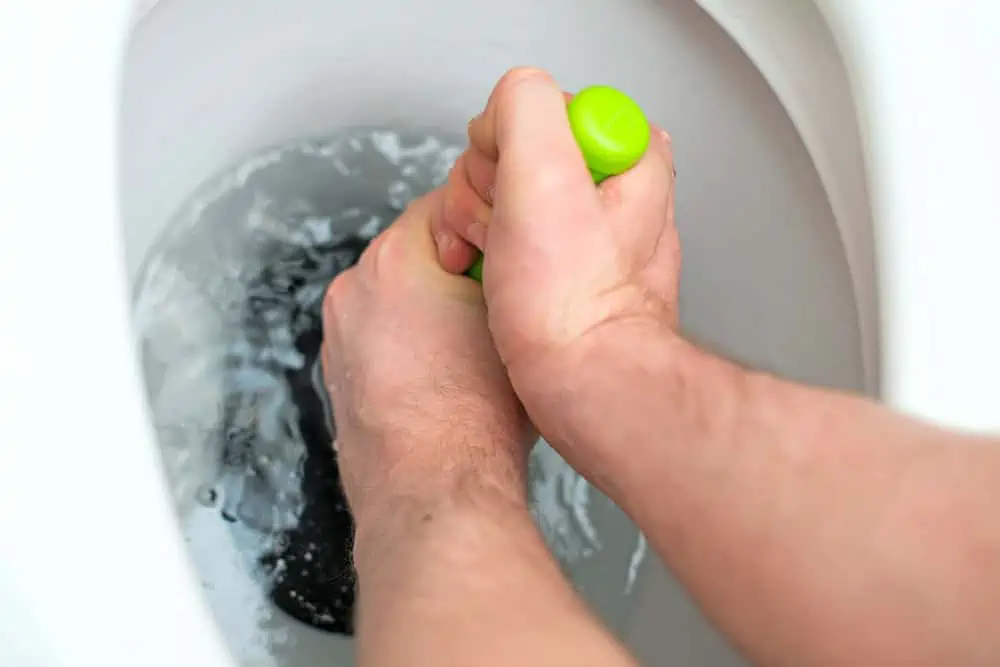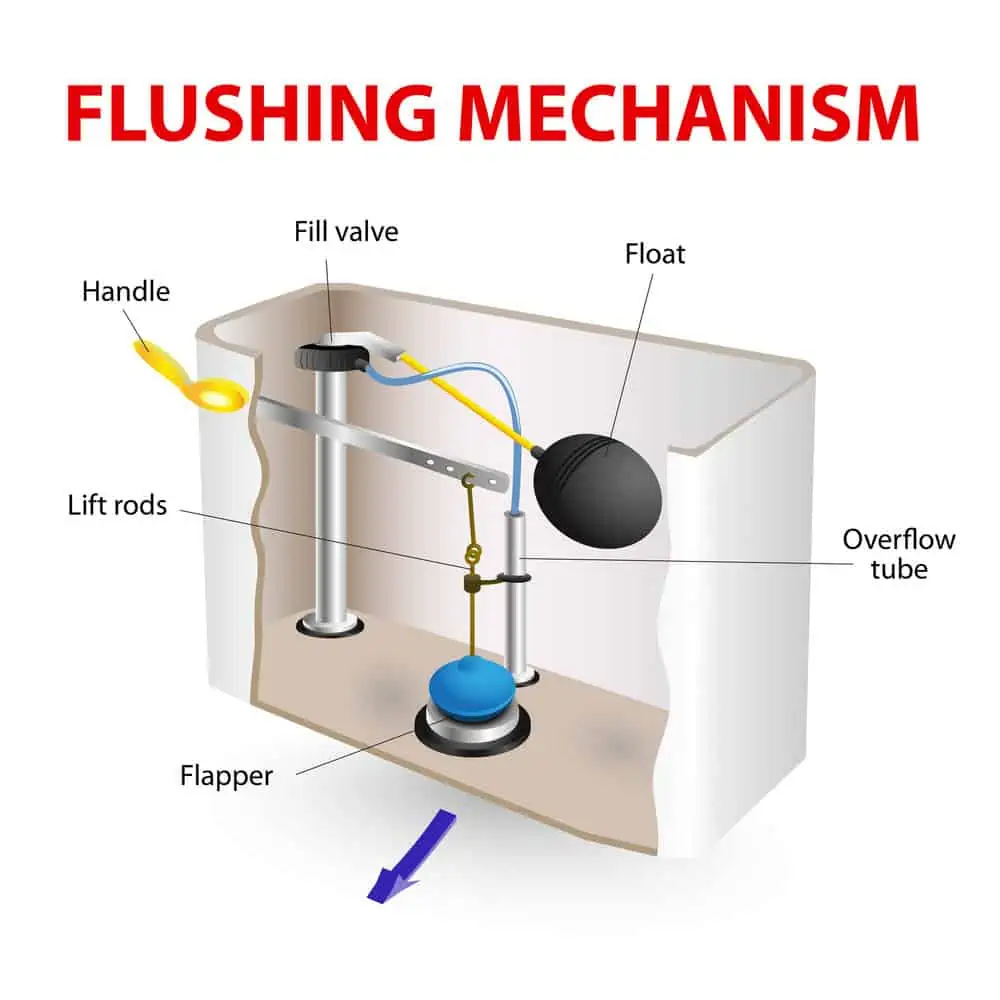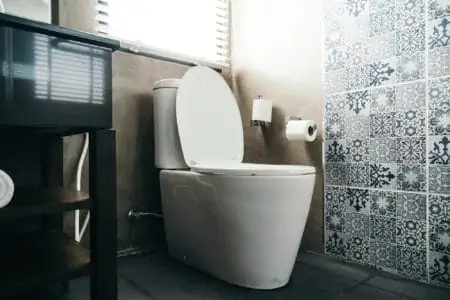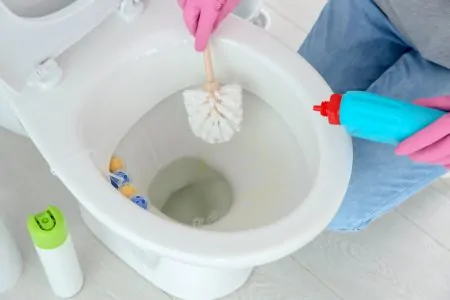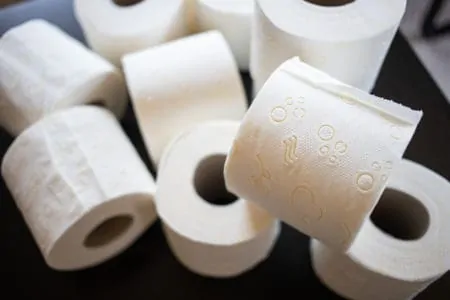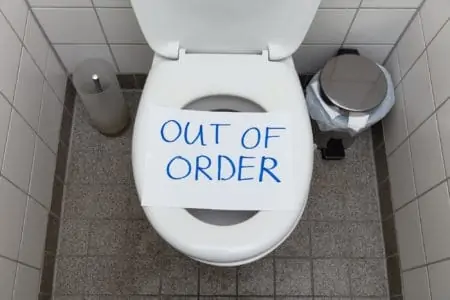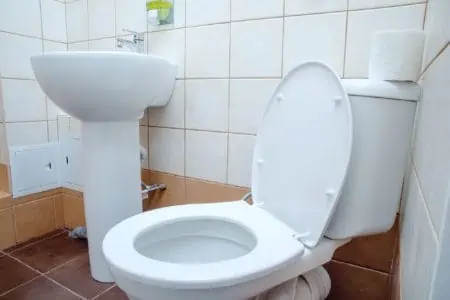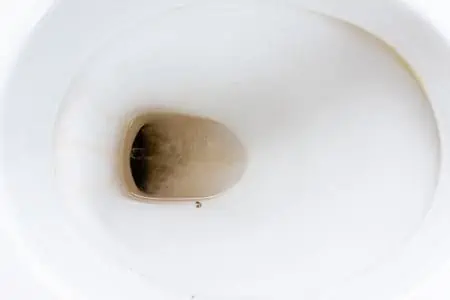Let’s face it; no one likes a toilet not flushing! Knowing how to fix a toilet that won’t flush is crucial if you want to save a packet on plumber fees. You can sort the issue there and then to get your toilet up and running.
Follow our guide to fixing a toilet that won’t flush as we show you the causes and explain when it’s best to call in the pros.
Key Takeaways
- Check Water Shut-Off Valve: Make sure it’s fully open to allow water flow to the toilet.
- Unclog the Toilet: Use a plunger, toilet snake, or chemical agent to clear any blockages.
- Replace the Flapper: Ensure it is sealing properly to prevent water leakage in the bowl.
- Clean Rim Holes: Dissolve mineral residue with white vinegar and water or use chemical bleach for stubborn blockages.
How to Fix a Toilet That Won’t Flush
Nothing sinks your heart like a non-flushing toilet. You realize just how vital a functioning toilet is when it is clogged or broken. Problems have a cause, so it’s time to look at them in detail.
Check Water Shut-Off Valve
Your water shut-off valve regulates the water flow from the supply pipe to the toilet. It is there for emergencies when you need to isolate the toilet for repairs.
The Problem
There is no water feeding to the toilet, causing the flush tank to not refill after initial flushing. Without a continuous water supply, your toilet won’t function properly. It’s an easy fix, especially when the toilet is not clogged.
How to Fix It
Locate the shut-off valve behind the toilet and check that it is fully open. You might have knocked it during heavy cleaning as part of your maintenance regime.
Some valves have a small handle that you turn counterclockwise. Others have a nut that rotates with a screwdriver. Once you open the water supply, wait while your flush tank refills before trying to flush the toilet.
Unclog the Toilet
Your toilet is clogged when you flush, and the waste comes back. A clogged toilet is no fun. It could have toilet paper wedged in the bowl or worse.
Either way, you risk flooding your bathroom if you don’t unclog the toilet.
The Problem
Technically, when you press the flush push button, the toilet flushes. However, the water does not drain all the way down. It swirls in the bowl and becomes trapped. The danger is that as the water fails to drain, the bowl fills.
A clogged toilet is one of the most common ways of flooding your bathroom. And the water that overspills is full of human waste. Nice!
How to Fix It
There are several ways to fix a clogged toilet: wait while gravity does its thing, use a toilet snake, plunger, or toilet brush, or use a chemical agent.
Using the gravity method involves doing nothing. Basically, toilet paper is designed to disintegrate in water, so if you leave it long enough, it mulches down and slides down the waste pipe on its own.
It’s that easy! However, it doesn’t always work, and it takes forever.
If you need the blockage gone ASAP, use a drain snake, rod, or toilet brush. The technique is a bit like reenacting the shower scene in Psycho. Stab at the pooey problem until it slides down the drain.
Finally, it’s time to go nuclear on this blockage. Use a chemical drain unblocker like Green Gobbler and wait while it eats away at the mass. Eventually, it dissolves the waste matter, taking the slide of shame to the sewer below.
Once you’ve unblocked your toilet, you can also use a chemical drain unblocker on your sink drains.
Replace the Flapper
The flapper is a crucial part of the internal components of your toilet. When you pull the flush pump handle, the flapper lifts to allow water to flood into the bowl. When the flush tank refills, the flapper closes to prevent water leakage in the bowl.
The Problem
When you pull the handle, the toilet flushes, and flushes, and… you get the picture. If this happens, the flapper has failed to seal the hole that stops the water flowing and allows the tank to refill.
Another sign that your flapper is flapping is a continuous trickle of water. It means that the flapper has closed over the hole but failed to seal properly.
How to Fix It
You will need to isolate your water supply at the water shut-off valve behind the toilet. Next, flush it a few times to empty the tank. Lift the lid on the flush tank, and you’ll see the flapper at the tank’s base, attached to a pull chain.
Unclip the chain, swap the flapper for a brand new one, and reattach the chain. Refill the tank and try the flush. If it only flushes once and the water stops running, you have been successful.
Check the Lift Chain
The lift chain attaches to the flapper. If it malfunctions, it could cause the toilet not to flush properly.
The Problem
The lift chain will either be too long or short. Too loose, the flapper won’t lift when you flush, and too short, and the flapper will lift but not close.
How to Fix It
With the tank drained, check the length of the chain. It should be taught, but not tight. There shouldn’t be any slack sections, and when the flush handle is in its resting position, the flapper should cover the drain hole.
You can easily add or remove chain links or replace the chain completely (replacement chains are available online and in hardware stores).
Clean Rim Holes
If you’ve ever stuck your head in your toilet (it’s as much fun as it sounds), you will see rim holes beneath the lip of the toilet. Some have two holes at the back of the bowl, while others have several.
Over time, these can become clogged, so it’s crucial you stick to a maintenance and cleaning regime.
The Problem
In hard water areas, scaling is a real problem. When the water flushes through the bowl, it leaves a chalky residue that blocks the rim holes and prevents them from functioning.
In extreme cases, mineral deposits can block the holes altogether, and you guessed it, your toilet won’t flush.
How to Fix It
Use white vinegar and water to dissolve the mineral residue clogging the rim holes. Mixing the vinegar and water into a spray bottle makes it easier to direct the spray. Coat the holes and wait for a couple of hours.
Next, grab a toilet brush and scrub like crazy. Eventually, the rim holes will unblock. You can use chemical bleach if you have an industrial-grade blockage.
Top Tip
Adding a few spoonfuls of baking soda to the white vinegar mix gives you extra cleaning power if the scaling is really bad.
Drain Line Problems
Sometimes, the problem has nothing to do with your toilet. It could be much deeper than that. The drain line carries waste matter from the toilet to the sewer.
If it blocks, it will back up to your toilet.
The Problem
There are several reasons why your drain line gets blocked. Tree roots could crack the pipework, or hardened matter could narrow the channel (cooking fat and food waste).
Take Note
If you notice all the toilets and sinks in your home failing to drain, the culprit is likely to be the drain line.
How to Fix It
You will need an extending auger, like this Rolson Drain Rod Set. It has a disc attachment and an auger to remove hardened matter. Screw the first two lengths together and push them into the drain via the street cover outside your property.
Keep adding lengths until you reach the blockage. Eventually, the drain will empty as the water begins to flow.
Important Point
Remember to twist the rods clockwise, or you risk them unthreading in your drain line.
Call a Professional
Sometimes you have to concede defeat and call in the pros. We recommend doing this if you’ve gone through the list above and the toilet still won’t flush properly. It could be an indicator of a more significant problem with your plumbing.
A plumber will know where to look and hopefully fix the issue. It’s an expensive option, but home ownership is not cheap. An emergency is precisely that and needs to be dealt with ASAP.
How to Flush a Toilet Manually
Another method is to fill a bucket with hot water (not boiling) and pour it down the toilet from a few feet above the bowl. The force of the water breaks up the blockage, and it slides down the waste pipe.
You may need to do this several times and keep an eye on the water levels in the toilet bowl. If you think you might flood the bathroom floor, stop.
FAQs
Flush(ed) With Success
Finding the answer to the question, “why won’t my toilet flush?” is a matter of trial and error. Plumbing issues are best resolved using the Chinese method of problem-solving. Number each issue and deal with them numerically.
If you look at each cause and solution in isolation, you will likely solve the problem. Once you’ve tried all of the above and still had no success, then it is time to call a plumber.
